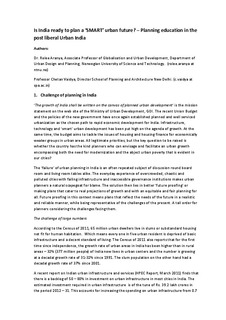Planning Education for a Smart Urban India
Original version
10.1007/978-981-10-0608-1_3Abstract
"The growth of India shall be written on the canvas of planned urbandevelopment ” is the mission statement of the Ministry of Urban Development, Government of India. Infrastructure, technology, and smart urban development have been put high on the agenda of growth. At the same time, government aims to tackle the issues of housing and housing finance for economically weaker groups in urban areas. All legitimate priorities, but the key question to be raised is whether the country has the kind planners who can envisage and facilitate an urban growth encompassing both the need for modernization and the abject urban poverty that is evident in our cities? This is the question that the authors attempt to answer by first discussing the main urban challenges of large number and size of urban settlements; informality and inequality; climate change and attendant disasters; and institutional challenges embedded in the historical legacy of planning. The authors express concern about the gap in skills imparted to students in Indian planning schools and the complex challenges facing the planning profession: need for modernization of urban areas while addressing systemic issues of inequality and poverty. Even before dealing with the issue of quality of planning education, authors believe that it is crucial to point out that just to meet the gap between the total requirement of planners and the current supply of planners, India must produce at least 8,000 planners every year for the next 20 years. This means that the existing student intake of 600 must be increased to 8,000 students. The authors suggest the following to address this dual challenge — increasing capacity and turnover of planners, updating of curricula to re flect skills required, addressing urban management within planning education and recognition of demand of planners in the public, private, and third sector.
